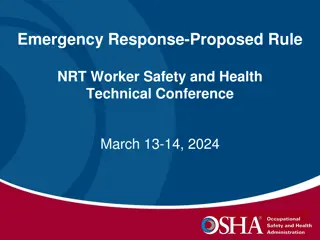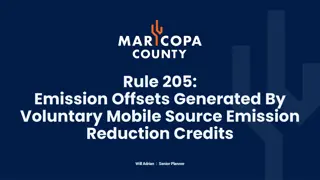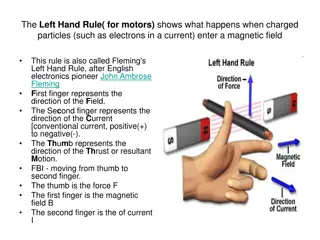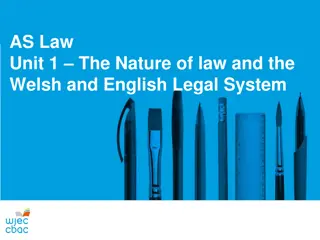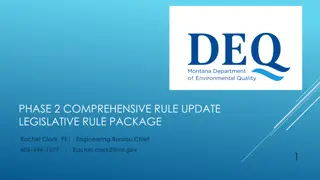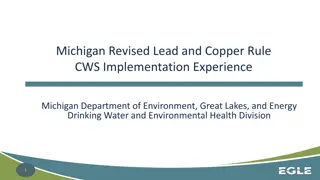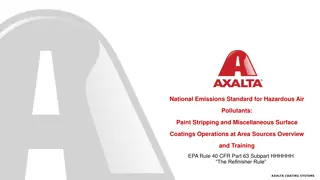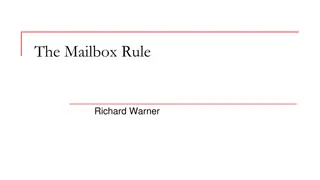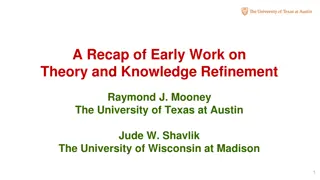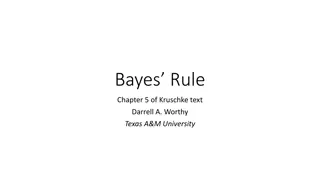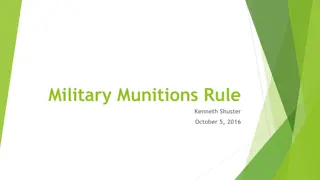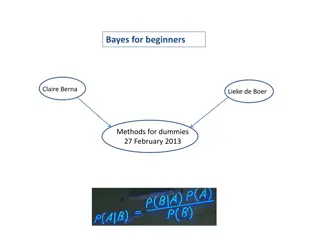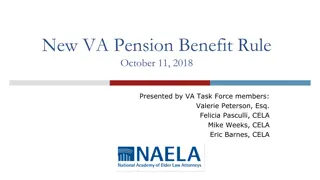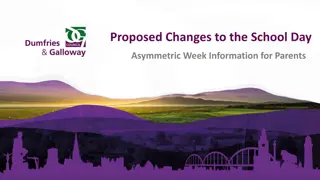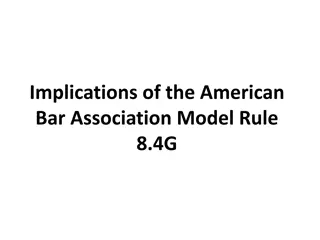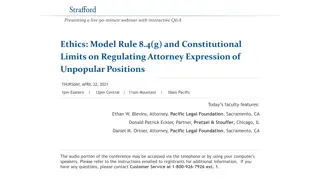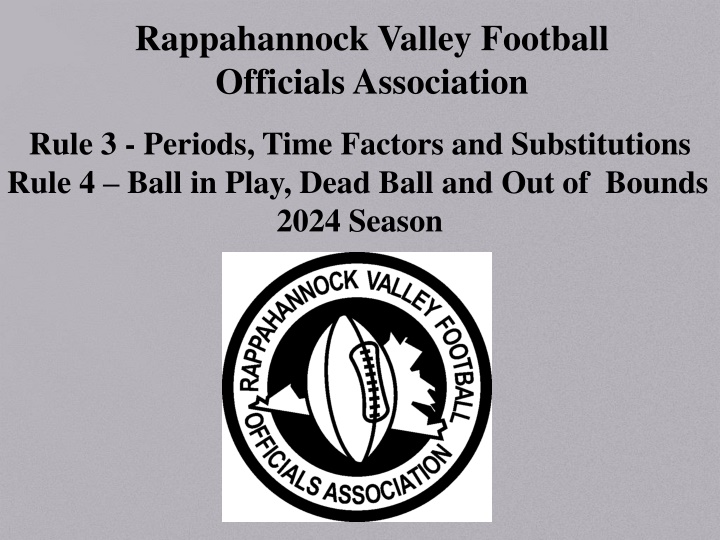
Rappahannock Valley Football Officials Association Regulations 2024
Explore the regulations of the Rappahannock Valley Football Officials Association for the 2024 season, covering periods, timing, substitutions, rule enforcement, and decision-making scenarios during games. Discover insights into timing factors, halftime regulations, referee decisions, and handling fouls during specific game situations.
Download Presentation

Please find below an Image/Link to download the presentation.
The content on the website is provided AS IS for your information and personal use only. It may not be sold, licensed, or shared on other websites without obtaining consent from the author. If you encounter any issues during the download, it is possible that the publisher has removed the file from their server.
You are allowed to download the files provided on this website for personal or commercial use, subject to the condition that they are used lawfully. All files are the property of their respective owners.
The content on the website is provided AS IS for your information and personal use only. It may not be sold, licensed, or shared on other websites without obtaining consent from the author.
E N D
Presentation Transcript
Rappahannock Valley Football Officials Association Rule 3 - Periods, Time Factors and Substitutions Rule 4 Ball in Play, Dead Ball and Out of Bounds 2024 Season
Table 3-1 Varsity F/JV MID PERIOD OF TIMING First Half: First period Intermission between periods Second period CLOCK TIME 12 minutes 10 minutes 8 minutes 1 minute 1 minute 1 minute 12 minutes 10 minutes 8 minutes Halftime Intermission: When Teams Leave the Field Mandatory Warm-up Period: Following halftime intermission Second Half: Third period Intermission between periods Fourth period Charged Time-outs 10 to 20 minutes 3 minutes 12 minutes 10 minutes 8 minutes 1 minute 1 minute 1 minute 12 minutes 10 minutes 8 minutes 1 minute *In our jurisdiction, Freshman games have been set at 8 minutes. Appendix H of the rule book says if an 7th or 8th grader plays with 9th graders, the game may have 10 minute periods.
Rule 3 Referees Decision 3.1.5 SITUATION B: During the third period, a thunderstorm moves into the area. The crew of game officials huddle to assess the situation. There is disagreement among the crew as to whether the game should be suspended. RULING: The referee will make the final decision. If possible, he should involve game administration from each school before making the final decision unless there is no time for discussion. Risk minimization must always be the primary consideration. COMMENT: Game officials should study and observe the NFHS Guidelines on Handling Contests During Lightning Disturbances as printed in the back of the NFHS Football Rules Book, as well as applicable state association guidelines. (1-1-5)
Halftime Intermission 3-1-6: Home management informs the game officials that halftime intermission will be extended for homecoming festivities to 30 minutes instead of the standard 15 minutes. Ruling: This is not permitted. The maximum length of halftime is 20 minutes without exception.
Rule 3 Fouls During a Down in which Time Expires 3.3.3 SITUATION A: With the score B-7 and A-6, it is second and goal from B's 9- yard line. The clock is stopped due to an incomplete pass with four seconds remaining in the game. A1's pass into the end zone is intercepted by B1 who runs to his 30-yard line where he is downed. Following the interception and during the run by B1, there is clipping in the end zone by B2. Time expires during the run. RULING: If the penalty for the foul by B2 is declined, the period is over. If the penalty is accepted, it results in a safety (two points) for A; however, the period is not extended. If this occurs at the end of period one or three, the teams will change ends of the field and B will kick from B's 20-yard line. (3-3- 4b(5))
Rule 3 Fouls During a Down in which Time Expires 3.3.3 SITUATION B: Near the end of the third period, it is third and 4 for A from B's 48-yard line. A1 advances to B's 45 and during the run there is holding by B1. The penalty is accepted. At the end of the down there are three seconds remaining in the period. Because the penalty was the only reason for the clock to be stopped, it is started with the ready-for-play signal and the period ends before A snaps the ball. RULING: A is not entitled to an untimed down as time did not expire during the down.
Rule 3 Fouls During a Down in which Time Expires What are the conditions needed for a period to be extended by an untimed down? Hint: there are four of them. a. There was a foul by either team and the penalty is accepted, except for those fouls listed in 3-3-4b. b. There was a double foul. c. There was an inadvertent whistle. d. If a touchdown was scored, the try is attempted unless the touchdown is scored during the last down of the fourth period and the point(s) would not affect the outcome of the game or playoff qualifying.
What are the situations where the period is not extended by an untimed down? 3-3-4b: 1. Unsportsmanlike fouls 2. Nonplayer fouls 3. Fouls that specify a loss of down. 4. Fouls that are enforced from the subsequent kick- off. 5. As well as when the defense fouls on a successful try or field goal, and the offended team chooses to enforce the penalty from the succeeding spot.
Rule 3 Inadvertent Whistle Rule 3 3.3.3 SITUATION C: During a down when time expires, A1 gains 10 yards and fumbles. The covering official inadvertently sounds his whistle while the ball is loose. RULING: The period shall be extended for an untimed down and A may put the ball in play where it lost possession or it may choose to replay the down from the previous spot. (3-3-3c)
Rule 3 Awarded Fair Catch Extends Period *3.3.3 SITUATION G: K1 punts on fourth and 15 from his own 20-yard line. R1 signals for a fair catch at R's 30. K2 commits kick-catching interference at R's 35 and time for the second period expires during the down. R2 recovers the kick at R's 28. RULING: If R declines the penalty, the period is over. If R accepts an awarded catch or has the penalty otherwise enforced, the period will be extended by an untimed down. (6-5-6 PENALTY)
Rule 3 Untimed Down? *3.3.4 SITUATION A: Time expires for the second quarter as A11 runs the ball beyond the line to gain and A11 then throws a forward pass to A9 who scores a touchdown. RULING: Team B will likely accept the penalty, which will negate the touchdown. The period will not be extended as A's foul contained a loss-of-down provision.
Rule 3 No Untimed Down 3.3.4 SITUATION B: The clock is running with 10 seconds remaining in the fourth period as A1 drops back about 4 yards and intentionally grounds a forward pass to stop the clock. The penalty is accepted, and B will likely decline the option to start the clock on the snap. The referee starts the clock on the ready following penalty enforcement and time expires before A can snap the ball. RULING: If B accepted the penalty for A's foul and declined the option to start the clock on the snap, the game is over. There is no untimed down as the clock did not expire during the down in which A1 committed the foul. (3-4-6, 3-4-7) Note: In this case, the incomplete pass was not the cause of the clock stopping, it was the foul. Thus, B has the option of starting the clock on the snap if they chose to.
Rule 3 End of Period 3.3.5 SITUATION A: A trails by three points in the fourth period with the ball on B s 20, fourth and 10 and two seconds on the clock. A1 throws an incomplete pass into B s end zone with time expired. The referee quickly glances to each sideline and then begins to leave the field. After the referee crosses the sideline, the referee hears the line judge blowing his whistle. The line judge explains that B1 committed pass interference during the down in which time expired. RULING: The game is not officially over even though the referee left the field. Since a foul had been called, the referee will give A a chance to accept the penalty and extend the period with an untimed down from B s 10-yard line. COMMENT: The game is officially over when the referee holds the ball overhead and leaves the field. Before doing this however, the referee should pause briefly and glance to both sidelines and make sure there are no fouls, no obvious timing error, no request for a coach referee conference, etc.
Rule 3 Starting and Stopping the Clock 3.4.2 SITUATION A: Near the end of the second period, there is a false start by A1 clearly for the purpose of stopping the clock: (a) in the first or third periods or with two minutes or more remaining in the second or fourth periods; or (b) with less than two minutes remaining in the second or fourth periods. When will the clock be restarted? RULING: In (a), because the foul was the only reason for stopping the clock, it will be restarted on the ready-for-play signal following the enforcement of the penalty unless the referee feels compelled to start the period on the snap by 3-4- 6. In (b), Team B shall have the option to start the clock on the snap. (3-4-7)
Rule 3 Starting and Stopping the Clock 3.4.2 SITUATION C: Near the end of a period with 28 seconds left, K1 punts on fourth down. During the kick, the covering official inadvertently sounds his whistle. The clock is stopped with 23 seconds remaining. RULING: The clock will be started with the ready-for- play signal. The down must be replayed. Note: K will not have to snap the ball on the replay
Rule 3 Starting and Stopping the Clock 3.4.3 SITUATION E: On fourth down (a) K1's punt is blocked by R1 behind the neutral zone where K2 recovers and advances beyond the line to gain, or (b) is stopped behind the line to gain. RULING: In (a) and (b) the clock will start on the snap because a new series has been awarded following a legal kick.
Rule 3 Timing Error 3.4.8 SITUATION: During the second down of a series, the field clock goes directly from 1:45 to :45 and is not detected. Following third down, time expires for either the first or second period: (a) before, or (b) after the referee has indicated the period has officially ended, the error is discovered. RULING: In (a), the timing error is correctable because it was discovered prior to the second live ball and before the period officially had ended. However, in (b), the timing error cannot be corrected whether it is the first or second period. (3-3-5)
Rule 3 Time Out, Conference, Successive, Heat 3.5.1 SITUATION B: Team A and Team B are in the third overtime series attempting to resolve a tied game using the NFHS- recommended Resolving Tied Games procedure. Team A has not utilized any time-outs during overtime. As Team B sets up for a field-goal attempt in the third overtime, Team A calls time-out. Following the time-out, the head coach requests another time-out due to the fact that he has not yet utilized a time-out during overtime. RULING: The request is denied because unless otherwise altered by the state association, the NFHS-recommended Resolving Tied Games procedure limits time-outs to one per overtime period.
Rule 3 Time Out, Conference, Successive, Heat 3.5.8 SITUATION A: During a charged time-out, an official's time-out for heat/humidity, a TV/radio time-out, or the intermission between the first and second or the third and fourth periods, or following a try: (a) team members of A confer with their head coach in front of the team box near the sideline; or (b) the coach of B goes to the huddle of B between the 9-yard marks, and talks to an assistant via a headset he brought to the huddle; or (c) the coach of B goes on the field and uses the time to berate and loudly question the referee regarding a previous play; or (d) the coach wishes to discuss the previous play with the referee; or (e) the head coach of A goes to the team huddle on the field for 30 seconds and then comes out and another coach takes his place for the rest of the time-out. RULING: It is a legal conference in (a) and (b). In (a), the players may use the headsets. In (b), the players may not use the headsets. In (c) and (e), it is illegal. In (d), this conference must be held at the sideline in front of the team box regardless of which authorized conference procedure is used. (2-6-2, 9-8-1c, 9-8-1i)
Rule Injured/Bleeding Player 3.5.10 SITUATION A: A game official stops the clock when he notices quarterback A1 has a bloody nose. A1 is directed to go to his team box. The coach of A then requests a time-out and A1's bleeding is stopped during the time-out. A1 re-enters with other teammates following the time-out. RULING: A1 must remain in the team box for at least one down. A time-out called after a game official has stopped the clock for an injured player does not allow the injured player to remain in the game. [3-5-8a(3), 3-5-8c, 3-5-10]
Rule 3 Helmet Comes Off 3.5.10 SITUATION E: During a down, the helmet of A1 or B1 comes off: (a) after an opponent grasps the face mask, chin strap or tooth and mouth protector; (b) after a legal block to the opponent; (c) after a legal block by an opponent; or (d) after either falls to the ground without contact; (e) after either falls to the ground immediately following the ball becoming dead. RULING: In (a), the player does not have to be replaced for one down. In (b), (c), (d) and (e), the player must be replaced for one down unless halftime or an overtime intermission occurs. When in doubt, and particularly when no foul is called, the player must be replaced for one down unless halftime or an overtime intermission occurs. An officials or charged team time-out does not exempt the player from being replaced for one down.
Rule 3 Misapplication of Rules 3.5.11 SITUATION A: It is third and 8 from A's 45 when A1 throws an incomplete - forward pass. Erroneously the ball is spotted at the 50, the ball marked ready for play, and K1 punts the ball into R's end zone. Following the down, the R captain requests a time-out so the coach may discuss the misapplication of the rules with the referee on the missed spotting of the ball after third down. RULING: It is too late to make any correction. The error had to be recognized and correction made before the ball was snapped on fourth down. This differs from a timing issue, where the error is discovered prior to the second live ball following the error. (3-4-8)
Rule 3 Misapplication of Rules 3.5.11 SITUATION B: Following a fourth-down incomplete forward pass late in the fourth period, a time-out is properly requested for a coach-referee conference regarding possible misapplication of a rule. (a) The coach of B questions a pass interference call on B1 during a second forward pass by A1; or (b) the coach of A questions why no pass interference by the defense was called and why the covering official inappropriately signaled that the pass was not catchable. In either case the referee determines the coach was correct and an incorrect ruling and inappropriate signal had been applied. RULING: In (a), the penalty marker is picked up. In (b), a penalty marker may be dropped, and the pass interference penalized. Misapplication of a rule or an incorrect signal may result in picking up a flag or dropping a marker to indicate a foul did occur and gives the appropriate signal.
Rule 3 Delay of Game/No Misapplication 3.6.2 SITUATION A: During the down, there is a foul by A1 and the penalty is enforced. The captain of A requests a time-out for a coach- referee conference regarding misapplication, even though A has no time-outs remaining. The referee confers with the coach and there is no change of decision. RULING: A will be penalized for delay of game and the clock will be started with the snap unless Rule 3-4-6 applies.
Rule 3 Substitutions 3.7.1 SITUATION A: Substitutes A12 and B12 properly enter the game between downs. The replaced player of A remains in the team huddle while the replaced B player leaves the field within three seconds. RULING: In this situation, A is charged with a 5-yard penalty (dead ball) for an illegal substitution because the replaced player of A did not leave within three seconds as required.
Rule 3 Substitutions 3.7.1 SITUATION B: A number of team substitutes enter the field between downs. The game officials do not recognize that one replaced player does not leave the field within three seconds. When the ball is snapped: (a) B12 is attempting to get off the field, or (b) A12 is in the formation as an extra lineman. RULING: In (a), it is an illegal substitution foul and in (b) it is illegal participation. COMMENT: In a related situation, if the covering official's count of players has determined there are more than 11 prior to the snap, a dead-ball illegal substitution foul should be charged since a replaced player(s) did not leave within three seconds. However, if the covering official's count is not completed before the snap is imminent or if the substitution has not been monitored, it becomes illegal participation at the snap if more than 11 are in the formation. Each team is responsible for substituting legally and for replaced players to leave within three seconds as required. (3-7-4, 9-6-4c)
Rule 3 Substitutions 3.7.3 SITUATION B: It is first and 10 on B's 12-yard line and substitute B12 comes onto the field to replace B2 and communicates with him. Prior to the ball becoming live: (a) B2 leaves the field of play through the end zone and across B's sideline without crossing the end line and continues toward his team box; or (b) B12, seeing that he will be unable to replace B2 before the ball is snapped, returns to his team box; or (c) B2, seeing that he will not be able to reach the sideline before the ball is snapped, leaves the field through the end zone and remains to observe the play; or (d) B12 becomes confused and withdraws through the end zone across the end line and goes around the field to return to B's team box. RULING: In (a), the act is legal. In (b), (c) and (d), it is a nonplayer foul for illegal substitution. A player, replaced player or substitute is required to go directly to his team box. A substitute may not enter and withdraw in the same dead ball interval.
Rule 3 Substitution 3.7.5 SITUATION A: Substitute (a) A1, or (b) B1, noticing his team has only 10 - players on the field, comes onto the field just as the ball is about to be snapped. RULING: In (a), A1 must be on the field on A's side of the neutral zone, inside the 9-yard marks, and not violate the shift or motion provisions. Furthermore, the act of his coming onto the field must not deceive the defensive team. In (b), the substitution is legal as long as B1 is on the field on B's side of the neutral zone prior to the snap. (3-7-6, 7-2-1, 7- 2-6, 7-2-7, 9-6-4)
Rule 4 Ball in Play, Dead Ball and Out of Bounds
Rule 4 Live Ball Strikes an Official or Dog Inbounds 4.1.5 SITUATION: A forward pass strikes: (a) a game official standing inbounds, after which it rebounds into the air and is caught by A1 or B1; or (b) a dog or a spectator inbounds. RULING: In (a), A1 or B1 has caught a live ball. Nothing has occurred to cause the ball to become dead. In (b), the ball becomes dead immediately and is administered under the provisions of the inadvertent-whistle rule with a replay of the down. (4-2-2e, 4-2-3a)
Rule 4 Holder with Knee on Ground 4.2.2 SITUATION B: During a try K1, who is apparently a place-kick holder, receives the snap with one knee on the ground and places the ball for a kick. Just as K2 comes forward to kick the ball, K1 lifts the ball, rises and: (a) throws a forward pass to K3 in the end zone; or (b) carries the ball into the end zone; or (c) starts to run, fumbles and the ball is recovered by K4 who advances into the end zone; or (d) fumbles and it is recovered by R1; or (e) takes several steps and then drops to one knee to place it for a kick. RULING: Successful try in (a), (b) and (c). The ball remains live and may be advanced since the place-kick holder had his knee in contact with the ground at the time of the snap and a teammate was in position to kick. In (d), the try ended with the recovery and R1 may not advance. In (e), the ball is dead immediately when K1's knee touches the ground after rising with the ball in his possession. (4-2-2a)
Rule 4 Holder with Knee on Ground 4.2.2 SITUATION C: At the snap, K1 is in position to kick and K2 is in position to hold for a place kick with one knee on the ground. The snap is high or bounces once and it is necessary for K2 to lift his knee off the ground in order to catch or recover the ball. K2 catches the snap and: (a) immediately drops to one knee and places the ball for a kick; or (b) immediately drops to his knees and then rises and passes the ball; or (c) takes several steps and then drops to his knees to place the ball; or (d) takes several steps and fumbles the ball which is subsequently recovered and advanced by K1 or K2. RULING: The ball remains live in (a), (b) and (d). In (c), the ball is dead when K2's knee touches the ground, because he did not go back down immediately after catching or recovering the errant snap. In (d), the advance by K1 or K2 is legal. (4-2-2a Exception)
Rule 4 Fair Catch Signal 4.2.2 SITUATION H: R1 gives a fair-catch signal immediately following his catch of a kick. RULING: Illegal fair-catch signal, because it was given after the kick was caught and R1 had become a runner. The signal does not cause the down to end. If accepted, the 5-yard penalty is enforced from the basic spot as defined in 10-4.
Rule 4 Fair Catch Signal 4.2.2 SITUATION G: K1 s punt on fourth and 10 is from his own 20-yard line. The kick is high and short. R1 gives a valid signal beyond the neutral zone and muffs the kick. The ball rebounds behind the neutral zone where: (a) K1 recovers the ball and advances to his 18-yard line; or (b) K1 falls on the ball at his 15-yard line; or (c) R2 falls on the ball at K s 9-yard line; or (d) R2 recovers the ball at K s 9-yard line and is tackled immediately. RULING: Legal advance by K1 in (a). It will be an automatic first down for K in both (a) and (b) because R1 touched the kick beyond the neutral zone. In (c), it is R s ball first and goal at K s 9-yard line. In (d), the signal by R1 causes the ball to become dead at the spot of recovery. The covering official should sound his whistle as soon as R2 or any other receiver recovers the ball. (4-2-2g, 6-1-5, 6-2-2, 6-2-3, 6-5-5)
Rule 4 Touching Ignored 4.2.2 SITUATION I: During a try, K1's place kick hits lineman K2 who is behind the neutral zone, and caroms between the uprights and above the crossbar. RULING: The try is successful. Touching a kick is ignored if the touching is in the neutral-zone expanded, or on K's side of it. It is important to remember the neutral zone does not expand into the end zone. If the same touching occurs beyond the plane of the goal line, the ball becomes dead and the try is ended. (2-28-2, 6-2-6)
Rule 4 Helmet Comes off Runner 4.2.2 SITUATION J: With fourth down and 8 from the 50, A1 runs to B's 45-yard line where: (a) B1, in attempting to tackle A1, unsnaps A1's chin strap and play continues to the 40-yard line where A1 is finally downed; or (b) B1, in attempting to tackle A1, grasps the face mask/helmet opening and A1's helmet comes off; or (c) B1 contacts A1 at B s 46 and A1 s helmet comes off and he subsequently fumbles the ball. RULING: In (a), play continues, and it is a first down for A after enforcement of the face mask foul. In (b), the ball becomes dead at the spot A1's helmet came off and B is penalized for the face-mask/helmet opening violation. In (c), the ball becomes dead at the spot where A1's helmet came off and because it was fourth down and the line to gain was not obtained, the ball goes over to B. The fumble is disregarded because it happened after the ball became dead and A1 must leave the field for one play. (3-5-10d, 4-2-2k)
Rule 4 Helmet Comes off Runner 4.2.2 SITUATION K: In attempting to tackle A1, B1's helmet comes completely off. A1 does not go down and he runs for a touchdown. RULING: The score stands. Play is not stopped, and the ball does not become dead if the helmet comes off any player other than the runner. B1 must leave the field for one play. (3-5-10d, 4-2-2k)
Rule 4 Inadvertent Whistle 4.2.3 SITUATION B: While a legal forward pass is in flight: (a) B1 interferes with eligible A1 and then there is an inadvertent whistle; or (b) a whistle is inadvertently sounded after which B2 contacts A2 while the ball is still in flight. RULING: In (a), if the captain accepts the penalty for a foul which occurred prior to the inadvertent whistle, the penalty takes precedence. It will be a new series for A, 15 yards in advance of the previous spot. In (b), the contact by B2 occurred during a dead-ball period and unless it is a personal foul, will be ignored. Because the whistle was inadvertently sounded while a legal forward pass was in flight, the down shall be replayed. (7-5-10a)
Rule 4 Inadvertent Whistle 4.2.3 SITUATION C: With fourth and goal on B s 4-yard line, A1 is hit and fumbles, and as the ball rolls into the end zone, an inadvertent whistle is sounded. The fumble occurs: (a) at the 5-yard line, or (b) at the 3-yard line. RULING: In (a) and (b), A will have a choice of taking the play at the spot of the fumble or replaying the down. If A takes the play, it is B s ball at the 5 in (a), and at the 3 in (b). COMMENT: Whenever an inadvertent whistle sounds while the ball is loose following a fumble, the ball is returned to the spot of the fumble or spot of last possession. Theoretically, this is where the ball becomes dead. Regardless of where the ball is fumbled, the team last in possession may choose to have the ball put in play where possession was lost and count the down or choose to replay the down. (4-2-3b)
Rule 4 Inadvertent Whistle 4.2.3 SITUATION D: A1 throws a forward pass from his own 40-yard line. B1 intercepts on his 2-yard line and circles back into his end zone. While B1 is in the end zone, the covering official inadvertently sounds his whistle. RULING: Since B1 is in possession, B has the option of accepting the results of the play at the time of the whistle or asking for a replay of the down. Since the result of the play would be a safety, B would normally choose to replay the down. (4-2-3c, 8-5-2a)
Rule 4 Inadvertent Whistle 4.2.3 SITUATION F: A1 is in scrimmage kick formation with his back heel near the end line in the end zone. On a high snap, the potential kicker jumps and is able to keep the ball from going out of the end zone. It falls to the ground and is rolling around 5 yards into the end zone. In a panic, A1 then kicks the ball off the ground and it rolls to the A25 and is bounding around when there is an inadvertent whistle. The ball rolls dead at the A27. RULING: B has a choice of accepting the penalty for an illegal kick, which if accepted, results in a safety against A. If the penalty is declined, the inadvertent whistle rule allows for A to ask for a replay of the down since the ball was not in player possession at the time of the whistle.
Rule 4 Inbounds Spot 4.3.3 SITUATION A: It is fourth down and the line to gain is B's 45-yard line. A1, running near the sideline, is blocked by B1 on the 46 and he: (a) travels several feet in the air landing out of bounds opposite B's 44 -yard line; or (b) lands inbounds on B's 44 and slides out of bounds. RULING: In (a), the covering official must locate the spot where the ball crossed the sideline and then determine whether the foremost point of the ball was behind or beyond the line to gain when A1 crossed the plane of the sideline. In (b), it is first down and 10 for A from B's 44-yard line.
Rule 4 Inbounds Spot 4.3.3 SITUATION B: A has third down and seven yards to gain at B's 30. A1 leaps near the sideline to attempt to catch a pass near B's 30-yard line. A1 is: (a) airborne trying to make the catch and is knocked backwards by B2 attempting to make the tackle and A1 lands outside the sideline at B's 32 or (b) airborne when he controls the ball attempting to complete the catch and is carried off the field by B2 landing out of bounds. RULING: In (a), the pass is incomplete, and the clock should start on the snap. In (b), it is a catch, and the clock should not stop. If the clock was stopped inadvertently by the covering official, it should be immediately restarted.. (2-15-1, 2-15- 2, 4-3-2)
Rule 4 Captains Choice on Placing Ball 4.3.6 SITUATION: Prior to the ready-for-play on a try, A's captain requests the ball be placed on the right-side hash mark. A then deploys in a spread formation. (a) A1 does not like the defensive coverage and requests a time-out; or (b) a dead-ball foul occurs. The captain of A then asks the referee to move the ball to a position midway between the uprights. RULING: The request is denied in (a) and honored in (b). The captain may, in seven situations, ask that the ball be placed at a certain point between the hash marks. However, once spotted the ball may not be moved because of a second request. If a dead-ball foul occurs, or a foul occurs during the down and the penalty is accepted, the captain again will be given an opportunity to pick a spot for the replay. The request for placement of the ball is permissible for a try or kickoff, after a safety, fair catch, awarded fair catch, touchback, or the start of each series, using the 10-Yard Line Overtime Procedure. (8-3-1)
Rule 4 Choice to Snap of Free Kick (Rule 4) 4.3.7 SITUATION: With the score tied near the end of the fourth period, R1 signals for a fair catch and catches the kick at K s 40. After a time-out, the captain of R advises the referee that he wishes to put the ball in play by snap. A1 throws a pass intended for A2. B1 interferes with A2, and the pass is incomplete. Following administration of the penalty, the captain of R decides to put the ball in play by free kick from K s 25 as a field-goal attempt. RULING: This is permissible, and the clock will not start until the kick is touched, other than first touching by K. This is one of the times a field goal may be scored by a free kick. The captain may request a time-out prior to making the decision on whether to snap or free kick. In putting the ball in play in this situation, the captain of R is privileged to designate the point on K s 25, anywhere between the hash marks he wishes the ball to be placed. (1-4-1, 5-2-4, 6-5-4)

